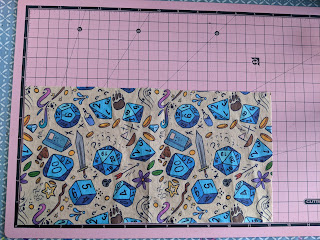Earlier today I made this little bag from a rectangle of scrap fabric. It's a very basic method - there are all sorts of ways this could be improved such as adding lining, a base or French seams. However, for a quick, easy make it works just fine!
I wanted to make a little bag for a nerdy friend - what better than this awesome dice/RPG/DnD themed fabric (from Spoonflower). I only had this rectangle left over from other projects.
Step 1: give it a good iron!
Step 2: fold in the ends, iron them down and pin. I folded them by 1/2 an inch. This fold will form the channel where the drawstring of the bag will go.
Step 3: sew down the folds making sure to sew close to the raw edge of the fold so you have enough space to feed the ribbon through later. Now fold the fabric in half with right sides together. The edges you've already sewn should meet together at the top. Pin then sew up the open sides - make sure to stop at the fold or you'll sew up the channel for the ribbon!
Step 4: turn the bag the right way round. I found that the folded edges weren't neat enough and overlapped a bit, which would make it hard to pull the ribbon through, so I carefully snipped them.











Comments
Post a Comment